

We may earn revenue from the products available on this page and participate in affiliate programs. Learn More ›
It’s hard not to love the fuzzy foliage of many African violets, plus the cheerful flowers. They thrive in average home conditions and rebloom multiple times all year long. With just a little attentive care, African violets can live for a half century or more. No wonder these low-maintenance houseplants are popular gifts, and the first houseplant for many gardeners.
African violets have a reputation of being easy plants to care for. The worst problem that typically happens is that they stop blooming. But as soon as you find and resolve the issue, they reward you with a fresh bloom display.
As a bonus, African violets are easy to share by propagating a single leaf. If you’ve been gifted a new African violet, or are struggling to get one to rebloom, these tips can help. Read on to learn all about growing African violet plants, from soil and water requirements to feeding and propagating.
African Violet Care At a Glance
Common Name: African Violet
Scientific Name: Saintpaulia spp.
Soil: coarse, well-drained
Light: medium to bright indirect
Water: medium; avoid wetting the leaves
Food: 14-12-14 African violet food
Temperature and Humidity: average indoor conditions, added humidity may be helpful
Propagation: leaf cuttings, division
Safety: nontoxic, may be problematic for allergy sufferers
African Violet Characteristics
The botanical genus Saintpaulia (Streptocarpus), the African violet includes several different types of flowering perennial. Despite their common name, they are not related to violas, but instead were given the name due to their pretty flowers. Although we typically think of purple African violets, they actually can bloom in a variety of shades, including blue, violet, lavender, pink, red-violet, lavender-pink, white, and purple. African violets are native to high-elevation tropical rainforests in Tanzania.
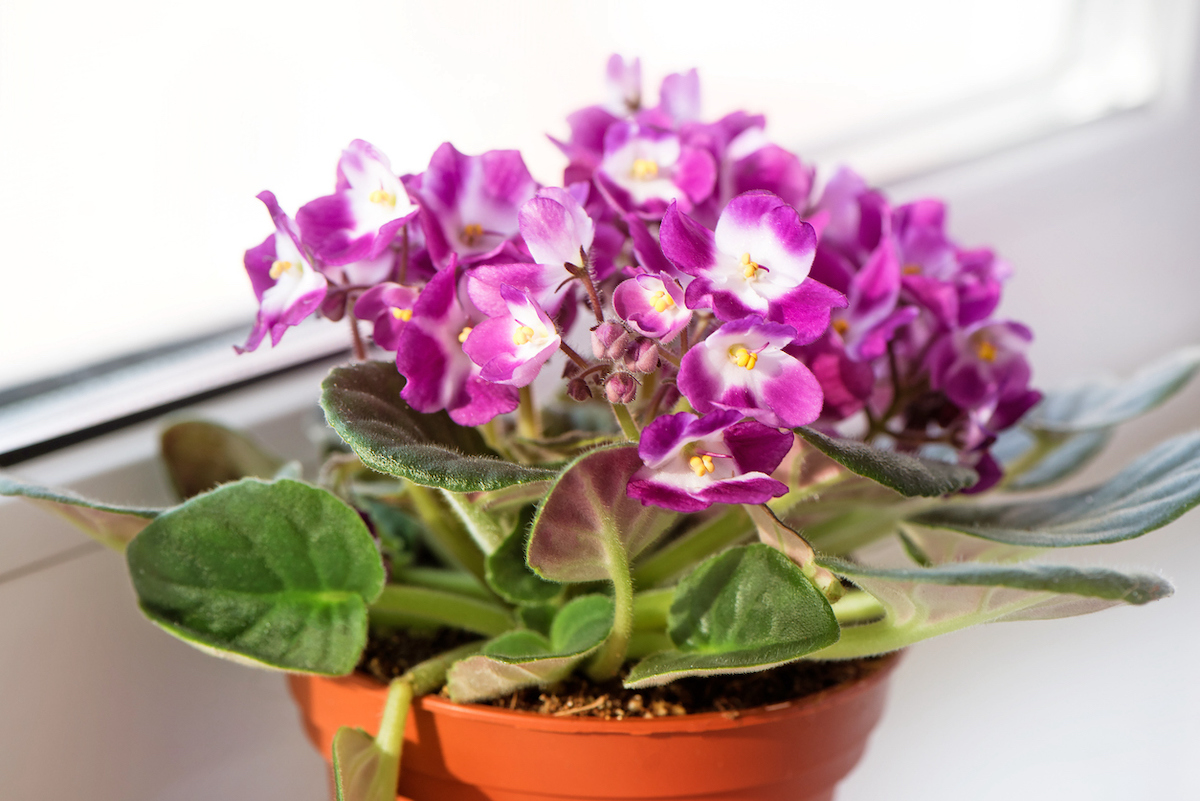
Other than the blooms, the most distinguishing characteristic of African violets is their fuzzy, succulent foliage. The fine hairs on the leaves are an adaptation to help the plant absorb water from the air. Some cultivars feature ruffled or variegated leaves which add to the ornamental value.
African violets grow from 2 to 6 inches tall, and anywhere from about 3 inches around to well over a foot, depending on the type. Most of the plants display flower clusters at the center, just above the foliage, surrounded by rosette-like layers of dark green leaves. Some cultivars feature flowers with semi-double or double layers of petals, bicolored flowers, trailing growth habits, or miniature size. Well-maintained plants can flower almost continuously.
Types of African Violet
Saintpaulia includes many different sizes, leaf and bloom characteristics, and flower colors. In all, there are more than 16,000 cultivars in existence, and the number continues to grow. In general, the African Violet Society of America, the body that registers these cultivars, breaks them down into the following major types:
- Standard African violets. These large violets grow in a low, compact rosette of layered foliage on a short stem with flowers clustered at the center. Once mature, they run from 8 inches around up to nearly 24 inches (large standard).
- Semiminiature violets reach a diameter of less than 8 inches.
- Miniature African violets grow to only about 6 inches around. This smaller African violet size is an excellent choice for display in tight spaces like terrariums.
- Trailing African violets have been developed in cultivation to grow multiple root crowns with elongated stems and leaf petioles that give the impression of a bushy or trailing growth habit.
- Species African violets are not cultivars, but the plants that grew wild in areas of Tanzania and Kenya. They do not necessarily grow in a rosette shape.
Hybridizers create cultivars based on type and plenty of other characteristics, including:
- Variegated leaves, which can have some amount of white or pink on their leaves, typically either white surrounded by green, adding to the ornamental effect.
- African violet flower types include a wide range of colors in the white-blue-red spectrum along with multiple colors, as well as semi-double and double layers of flower petals.
- Leaf types offer another element of ornamental value, with at least 11 different shape categories in existence, including girl-shaped, holly-shaped, ruffled-edge, longifolia-shaped, heart-shaped, ovate, pointed, round, scalloped-edge, serrated-edge, and spoon-shaped leaves.
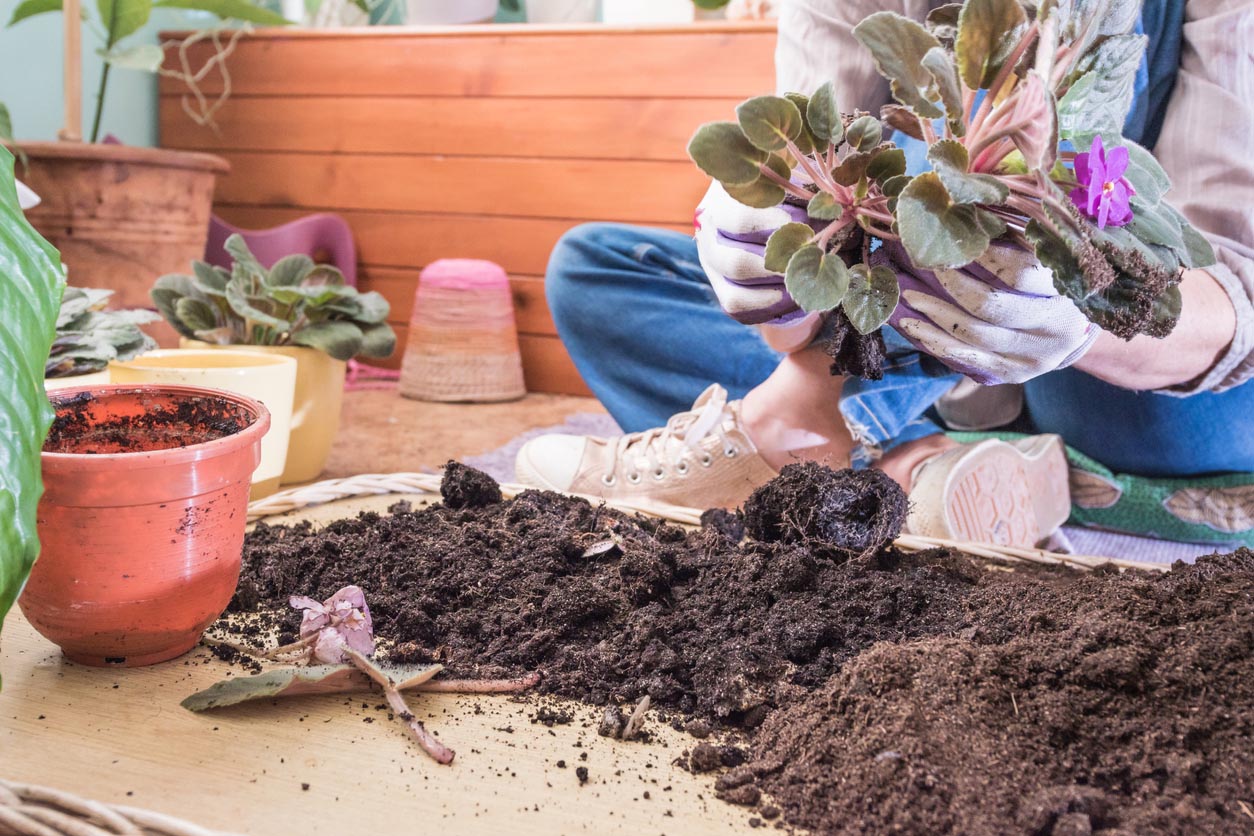
Selecting Soil for African Violets
African violets should be repotted whenever the plant becomes pot-bound, typically every 6 months or so. For the best results, choose a soil mix that is loose, porous, and that drains well. Regular potting soil might work, but soil mix designed specifically for African violets will likely be best.
Good African violet soil contains no actual soil. A quality soilless mix is made with a base of sphagnum peat moss along with some sand, perlite, or vermiculite to improve aeration (available on Amazon). Due to the acidity of the peat moss, some lime or calcium carbonate may be added to balance the pH, which should measure 5.8 to 6.2. Finally, a small amount of fertilizer will be included in the mix.
When choosing the pot, go small. African violets typically bloom (and rebloom) best if the pot they live in is about one-third the diameter of the plant’s leaf rosette.
Related: 20 Flowering Houseplants That Will Add Beauty to Your Home
The Right Light
If your African violet has stopped flowering, take note of the lighting in the room. African violets grow and flower best in bright, indirect light. There should be adequate natural light to make your hand cast a shadow on the plant throughout the daytime hours. But avoid direct sunlight. Near south- or west-facing windows, the sun’s direct rays can be diffused through a sheer curtain.
You also can use LED or fluorescent grow lights on African violets, generally with the crown about 8 to 10 inches below the light source. Whether you use natural or artificial light, be sure to turn the violets every week or so for even growth.
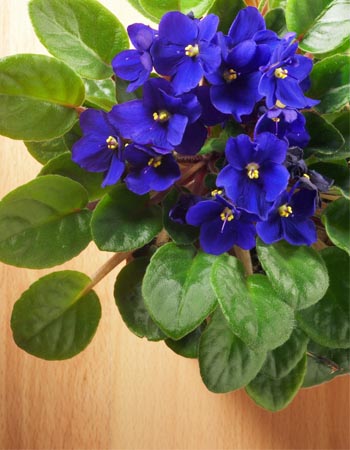
Watering African Violets
Watering is an African violet’s major point of sensitivity. Lack of water leads to shriveled roots, loss of vigor, and collapse. Overwatering causes flower loss, limpness, and crown rot or stem rot and death. The good news is that it’s really not that hard to get it right. In moderate humidity, weekly watering is generally adequate.
The best way to know if your plant needs water is to touch the soil surface. If it’s dry to the touch, it is time to water. African violets should always dry out briefly between waterings to ensure that adequate air gets all the way down to the roots. Use day-old water. Fill the watering can ahead of time to let the water come to room temperature and allow chlorine to evaporate.
When you water your African violet, avoid wetting the leaves. Water droplets that stay on the leaves can cause spotting. If you accidentally get water on the foliage, gently soak it up with a paper towel or soft tissue. Thoroughly wet the soil and empty any runoff water from the plant saucer.
Fertilizing African Violets
If you want your flowers to bloom the bluest shade of blue, African violet fertilizer is a must (available on Amazon). Apply a balanced and liquid plant food with each watering for best overall plant health and consistent, colorful blooms. Adjust the fertilizer label directions for weekly feedings to avoid overfertilization. If the fertilizer label instructions are for monthly applications, dilute the fertilizer to quarter-strength to feed each week.
Setting the Temperature and Humidity
African violets grow well in the environmental conditions that people live in. Average home temperatures and humidity levels work well. In air temperatures around 70 degrees, and 50 to 60 percent relative humidity, they’ll thrive.
If you need to boost humidity, add a pebble tray. Simply fill a large plant saucer with quarter- to half-inch stones and add water (available on Amazon). Place the African violet plant on the pebble tray and refill the water as needed. As the water evaporates, the air around the plant gains a humidity boost.
Related: 11 Things You Didn’t Know That Houseplants Love
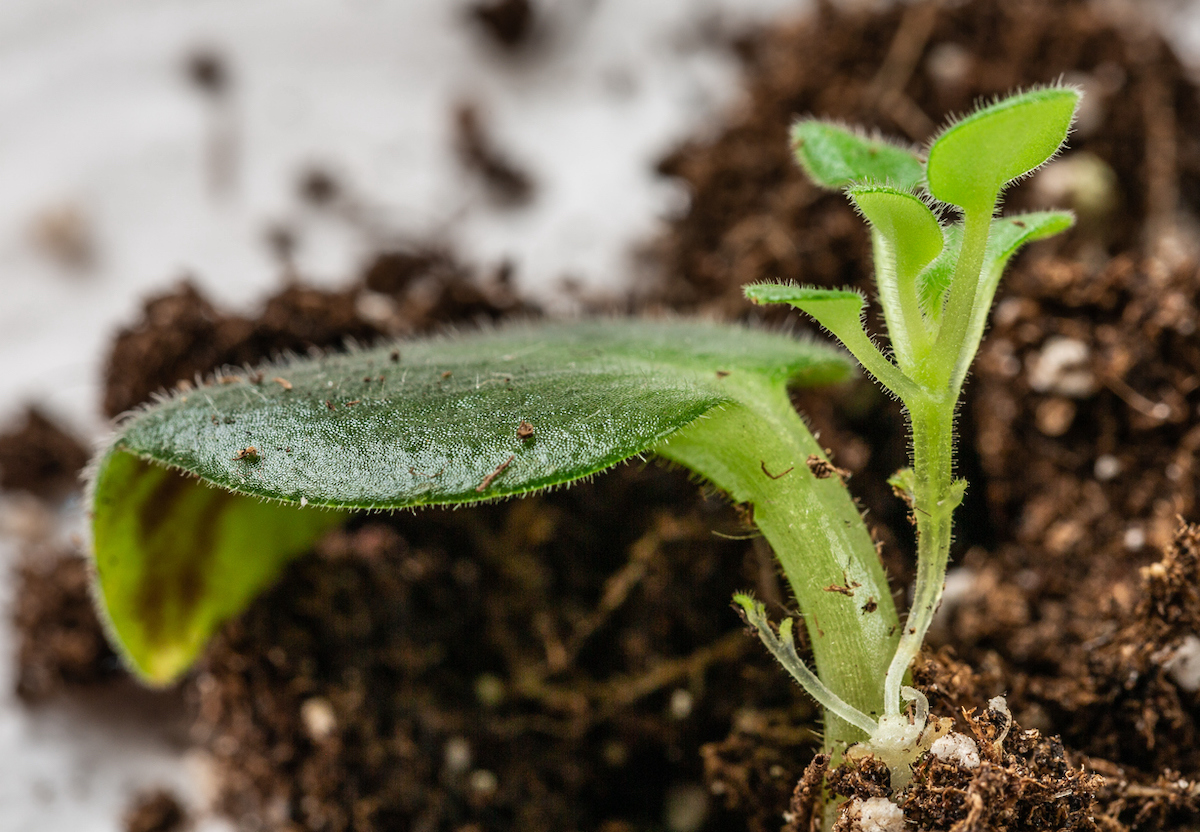
Propagating African Violets
African violets can be propagated with seeds, by division, or by leaf cuttings. Growing them from seeds takes the most time and detailed care. Mature plants can be divided if they grow from multiple root crowns. Leaf cuttings are far and away the most popular method of starting new plants.
How to propagate an African violet from a leaf cutting
- Fill a 2-inch pot with premoistened African violet soil. Use a chopstick or skewer to create a 1.5 inch deep planting hole for the cutting.
- Pinch out a healthy leaf from the middle row of foliage on a mature plant.
- Use a sharp knife to trim the leaf stem down to 1.5 inches long, on a 45-degree angle.
- Apply rooting hormone to the cut leaf stem and insert it into the planting hole in the soil up to the base of the leaf.
- Water lightly around the base of the cutting to close the planting hole.
- Place the pot with the cutting inside a zipper-seal plastic bag to create a humid greenhouse. Do not let the cover contact the cutting. Place it in bright, indirect light.
- Humidity should condense on the walls of the bag. If not, add a little water to the soil.
- Monitor the setup weekly. In about 4 weeks, tiny plantlets should appear at the soil surface.
- Eight to 12 weeks after the plantlets first appear, when they have four leaves apiece, the baby plants will be mature enough to separate and pot up into their own containers.
Alternatively, propagate in water instead of soil. Fill a wide-mouth container with lukewarm water and cover it tightly with plastic wrap. Poke holes into the plastic and insert the leaf stem, prepared as mentioned above for rooting. Change the water weekly. Add a drop or two of fertilizer when plantlets appear. When the baby plants are about a half-inch in size, pot them up.
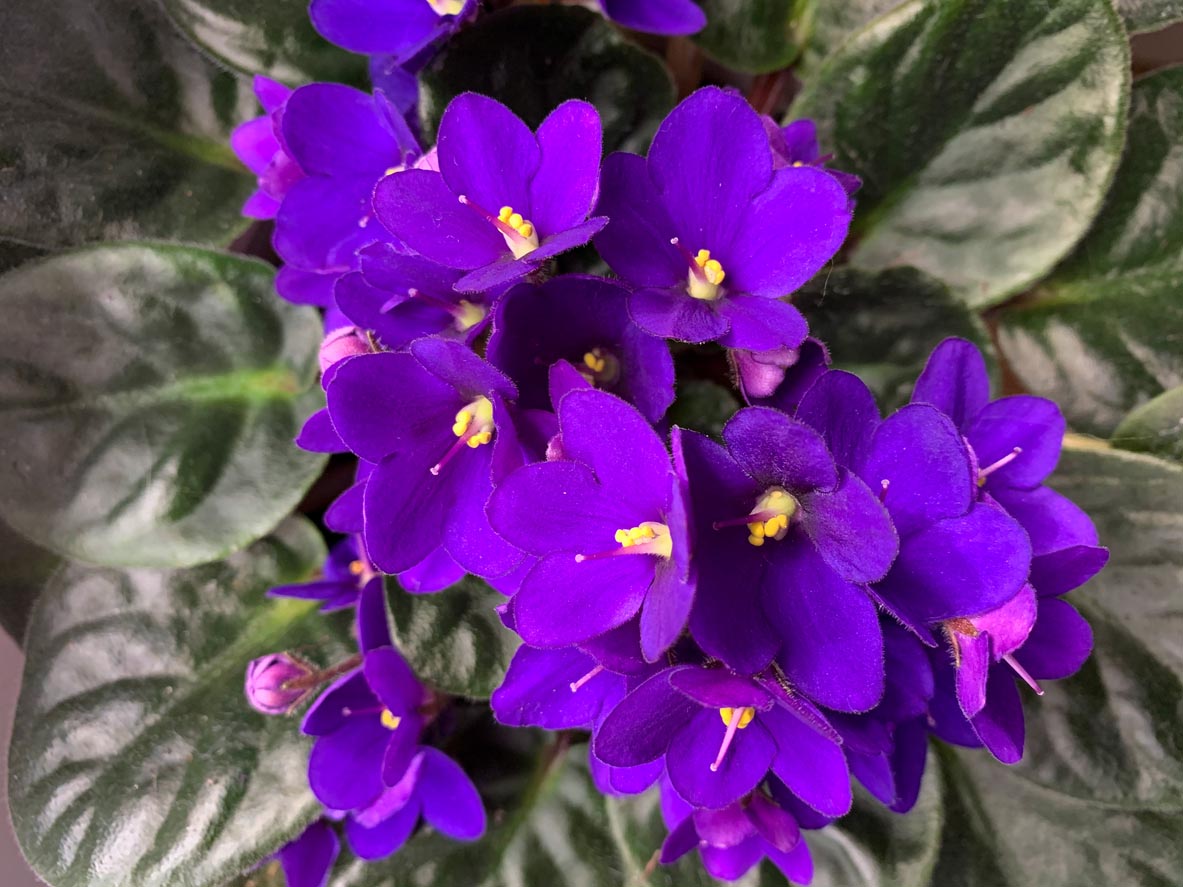
Safety Considerations
From a toxicity standpoint, African violets are one of the safest houseplants. With no known toxicity, they are an excellent choice for those with children or pets. Allergy sufferers, however, should be warned that, although pollen is a non-issue, these beauties can trap dust and other fine allergen particles on their fuzzy leaves.
Related: Count On These 25 Indoor Plants for Easy Color Year-Round
Potential Pests and Diseases
Overwatering is the leading cause of death for African violets by far. While virtually no insect pests pose a consistent threat, thrips can show up on the plants, and several fungal diseases can cause problems. Crown rot and root rot caused by the fungi Pythium and Phytophthera, and blight caused by the Botrytis fungus are all directly or indirectly caused by overwatering.
Prevent disease problems by using a porous potting mix, choosing pots with ample drainage holes, and watering properly. Remove old, dead leaves as they fade to eliminate breeding areas for pests.
With the right light, soil, pot, and other conditions, many African violets will rebloom every few months.
FAQs About African Violet Care
Growing African violets is one of the most rewarding choices for new houseplant growers. If you’re ready to get started, or have struggled in the past, these FAQs can help.
African violet flowering is directly related to the overall growing environment. Plants should be grown in bright, indirect light. The soil should be allowed to dry at the surface between waterings, but kept consistently moist at the root zone. Apply a weak solution of balanced liquid fertilizer at each watering for a consistent nutrient supply. Finally, repot the plant if the soil wears out, as noted by an increasing amount of fine dust, rather than coarse particles.
African violets do not respond well to direct sunlight. In a bright windowsill, the light should be diffused behind a sheer curtain or thin blind.
Water your African violets when the soil surface dries out, rather than on a timed schedule. Under average conditions, this may be weekly. However, pot size, plant condition, soil condition, temperature, relative humidity, and other factors can dictate a different schedule.
